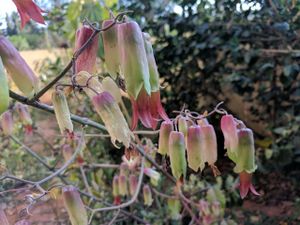Note: This is a project under development. The articles on this wiki are just being initiated and broadly incomplete. You can Help creating new pages.
Kalanchoe pinnata - Asthibhaksha
Bryophyllum is a plant genus of the Crassulaceae family that has sometimes been included within the genus Kalanchoe. There are about forty species in the group, native originally of South Africa, Madagascar, and Asia. The group is notable for vegetatively growing small plantlets on the fringes of the leaves; these eventually drop off and root. These plantlets arise from mitosis of meristematic-type tissue in notches in the leaves.Nowadays, bryophyllums are naturalised in many parts of the tropics, and deliberately cultivated for their attractiveness or for their interesting reproduction.
Uses
cough, asthma, cold with candy sugar, dysentery, blood pressure, cardiac problem, fever, Diarrhea, constipation[1]
Parts Used
Chemical Composition
Bufadienolide compounds isolated from Bryophyllum pinnatum include bryophillin A which showed strong anti-tumor promoting activity in vitro, and bersaldegenin-3-acetate and bryophillin C which were less active. Bryophillin C also showed insecticidal properties.
Common names
| Language | Common name |
|---|---|
| Kannada | Gandukalinga |
| Hindi | Jakh me hayat |
| Malayalam | |
| Tamil | Malaikkalli, Runakkalli |
| Telugu | |
| Marathi | NA |
| Gujarathi | NA |
| Punjabi | NA |
| Kashmiri | NA |
| Sanskrit | Parn beej, Raktakusum |
| English | Life plant, Cathedral Bells |
Habit
Identification
Leaf
| Kind | Shape | Feature |
|---|---|---|
| Simple | succulent | They are oppositely arranged, flattened, and the number of leaflets present varies from one near the base of the stems to three or five |
.[2]
Flower
| Type | Size | Color and composition | Stamen | More information |
|---|---|---|---|---|
| bell-shaped | up to 7 cm long | yellowish-green or pale green | 5-20 | flowers are arranged in branched clusters at the tips of the stems |
Fruit
| Type | Size | Mass | Appearance | Seeds | More information |
|---|---|---|---|---|---|
| papery and membranous | 15 mm long | with four slender compartments (i.e. carpels). They generally remain enclosed within the old flower parts and contain numerous minute, slender, brownish-coloured seeds | {{{6}}} |
Other features
List of Ayurvedic medicine in which the herb is used
- Vishatinduka Taila as root juice extract
Where to get the saplings
Mode of Propagation
How to plant/cultivate
Widely cultivated as a garden ornamental in Australia, and still be commonly seen growing in gardens[3]
Commonly seen growing in areas
Photo Gallery
References
External Links
- Pages that are stubs
- Ayurvedic Herbs known to be helpful to treat cough
- Ayurvedic Herbs known to be helpful to treat asthma
- Ayurvedic Herbs known to be helpful to treat cold with candy sugar
- Ayurvedic Herbs known to be helpful to treat dysentery
- Ayurvedic Herbs known to be helpful to treat blood pressure
- Ayurvedic Herbs known to be helpful to treat cardiac problem
- Ayurvedic Herbs known to be helpful to treat fever
- Ayurvedic Herbs known to be helpful to treat Diarrhea
- Ayurvedic Herbs known to be helpful to treat constipation
- Herbs with Leaves used in medicine
- Herbs with common name in Kannada
- Herbs with common name in Hindi
- Herbs with common name in Tamil
- Herbs with common name in Sanskrit
- Herbs with common name in English
- Habit - perennial succulent herbs
- Index of Plants which can be propagated by Seeds
- Index of Plants which can be propagated by Cuttings
- Herbs that are commonly seen in the region of weed in banks
- Herbs that are commonly seen in the region of hummocks
- Herbs that are commonly seen in the region of waste grounds
- Herbs that are commonly seen in the region of wet regions
- Herbs

